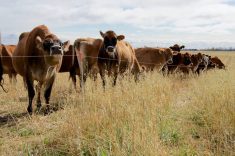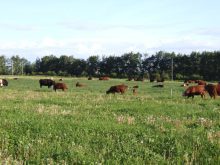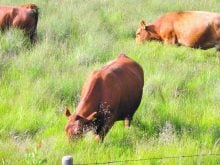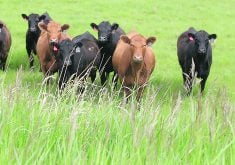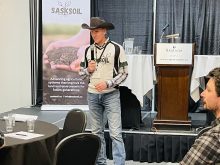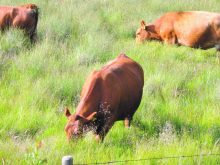Livestock producers are advised to protect their animals by identifying plants that can cause acute or chronic poisoning
REGINA — Turning cattle onto fresh spring pasture can come with risks from the plants growing there.
Some plants are acutely toxic and others cause chronic poisoning. These include weeds that have appeared during the last few years of drought as water body boundaries receded.
Jennifer Hayden and Chelsea Siemens, livestock and feed extension specialists in North Battleford and Kindersley, Sask., respectively, discussed some of the plants and the problems they present during a recent webinar held by Alberta Agrisystems Living Lab.
They said toxins can be more potent in spring leaves than those grown later in the season.
Read Also

House ag committee to undertake several studies
The House of Commons standing agriculture committee has set its agenda for the coming months. Members began the fall sitting with a two-hour update on international trade
“If the toxin is in the leaves, maybe spring is going to be a more sensitive time of year,” Hayden said. “If the toxins are in the seeds, well then maybe fall is when we see that.”
Lots of poisonous plants produce toxins that discourage cattle from grazing them. A bad taste or smell can repel potential grazers.
But some dangerous plants are quite palatable, which is a problem particularly during dry periods when other plants are scarce.
“(Cattle are) going to look for something that’s green and they’re going to eat those up,” she said.
Producers who graze cattle in an area that hasn’t been used before should be sure to identify the plants growing there.
Hayden said in 2021 there were quite a few cases of cattle grazing in places where water had receded, allowing access to aquatic plants with potentially high mineral concentrations. Water hemlock and seaside arrow grass are among those that appear in these situations. Both can cause acute toxicity and sudden death.
Siemens said water hemlock is probably the most toxic poisonous plant.
“It’s one of those where it causes acute toxicity and can be lethal to cows and other livestock in very small amounts.”
The toxin acts on the nervous system and acts quickly. No amount is safe.
“Often the only thing that we will see is dead livestock in the close vicinity to water hemlock,” she said. “The last two summers saw a fair number of cases of water hemlock poisoning in west-central Saskatchewan.”
The plant can be identified by its leaves and enlarged bulb at the bottom of the stalk. The bulb has horizontal membranes dividing it, but Siemens urged caution when opening the stalk to look at the bulb.
“The bottom of the stalk is the most toxic part of the sap within there and it’s also very toxic to humans.”
Producers should identify the plant and then restrict access if possible. Cow parsnip and water parsnip look quite similar to water hemlock but aren’t toxic.
Seaside arrow grass is also acutely toxic in small amounts because of the cyanide it contains.
Symptoms of this poisoning include nervousness, trembling, erratic breathing and death. A post mortem would show bright red blood and the smell of bitter almonds in the stomach.
Siemens said toxicity persists if the plant is put up in hay.
This plant grows rapidly in spring, is often found in saline or wet areas and grows with other rushes and sedges, which makes it hard to distinguish. It accumulates salt from the soil, which can be a risk factor if cattle are looking for salt and don’t have another source, Siemens said.
A third plant to watch for is death camas, which is common in Saskatchewan and Alberta. All parts of this plant are poisonous, especially the bulb, and it looks like a wild onion but doesn’t have the smell. It also has a v-shaped leaf compared to flat onion leaves.
While death camas mostly affects sheep, it can harm cattle too. Similar to the other two plants, it takes a small amount to cause death and is poisonous in hay.
Other plants cause chronic poisoning that leads to reduced gain and animals that don’t do well.
These include kochia, which contains oxalates that cause kidney failure, brassicas that contain glucosinolates that interfere with thyroid function, and others.
Hayden said it’s difficult to say how much of these can be safely grazed or used in a ration because they are hard to test for.
Alkaloids can irritate the digestive tract and act on the central nervous system, depending on the type.
“So if we’re talking about ergot, we may find that in rye, triticale, wheat, sometimes even barley,” Hayden said.
Alkaloids can also be found in smooth brome grass, although not often.
Cyanogens, such as those in flax, interfere with oxygen exchange from the lungs to the body tissues.
“The various tissues, including the brain, are then starved for oxygen so those animals generally perish from asphyxiation. Often these are one of those where we see that acute poisoning and it’s something that’s going to happen quickly.”
Nitrates also cause oxygen asphyxiation, which can be acute or chronic.
Another type of poisoning could occur from fungus or mould with associated mycotoxins, such as ergot or fusarium with vomitoxin.
Finally, some plants lead to photosensitization or mechanical injury.
Photosensitization can present as blistering on a muzzle or udder. Mechanical injury would occur from grasses with long awns that can cause discomfort.
Common acute poisoning symptoms include standing alone, disorientation and changes that happen quickly.
Signs of chronic poisoning include head lowering, being generally unthrifty and not looking well, refusing feed and a shaggy coat.
Hayden said the diagnosis is not always easy because there are lots of contributing factors. Treatment is not always possible.
What else might be of concern in the pasture?
Kochia drew a lot of attention in recent dry years because it’s a good source of energy and protein, but it can be high in oxalates, sulfur and nitrates. Siemens said feed can be tested for the latter two but not for oxalates.
“That’s where we have a general recommendation to keep that kochia to 25 to 30 per cent maximum in the total ration in order to make sure that oxalate content doesn’t exceed the levels where it’s likely to cause issues.”
She said producers should get analyses of sulfur and nitrates at the lab. Some will only confirm presence, while others give the percentage.
If preserved feed contains kochia, other feed should be added to create a safe ration, she said.
Lambs quarters and red root pigweed can also be high in oxalates and accumulate nitrates.
Wild mustard and stinkweed contribute to chronic poisoning because they contain glucosinolates.
Field horsetail, common groundsel, leafy spurge, early yellow locoweed and reed canary grass are all concerns. Low larkspur, found in the Cypress Hills, is palatable but poisonous. Lupins can cause calf deformities and milk vetches can accumulate large levels of selenium.
Siemens said even chokecherry and saskatoon berry leaves and branches are risks because they contain cyanide. About six to seven pounds would be lethal to a fully grown cow.
While cattle likely wouldn’t willingly consume these, they might if there is nothing else available.






